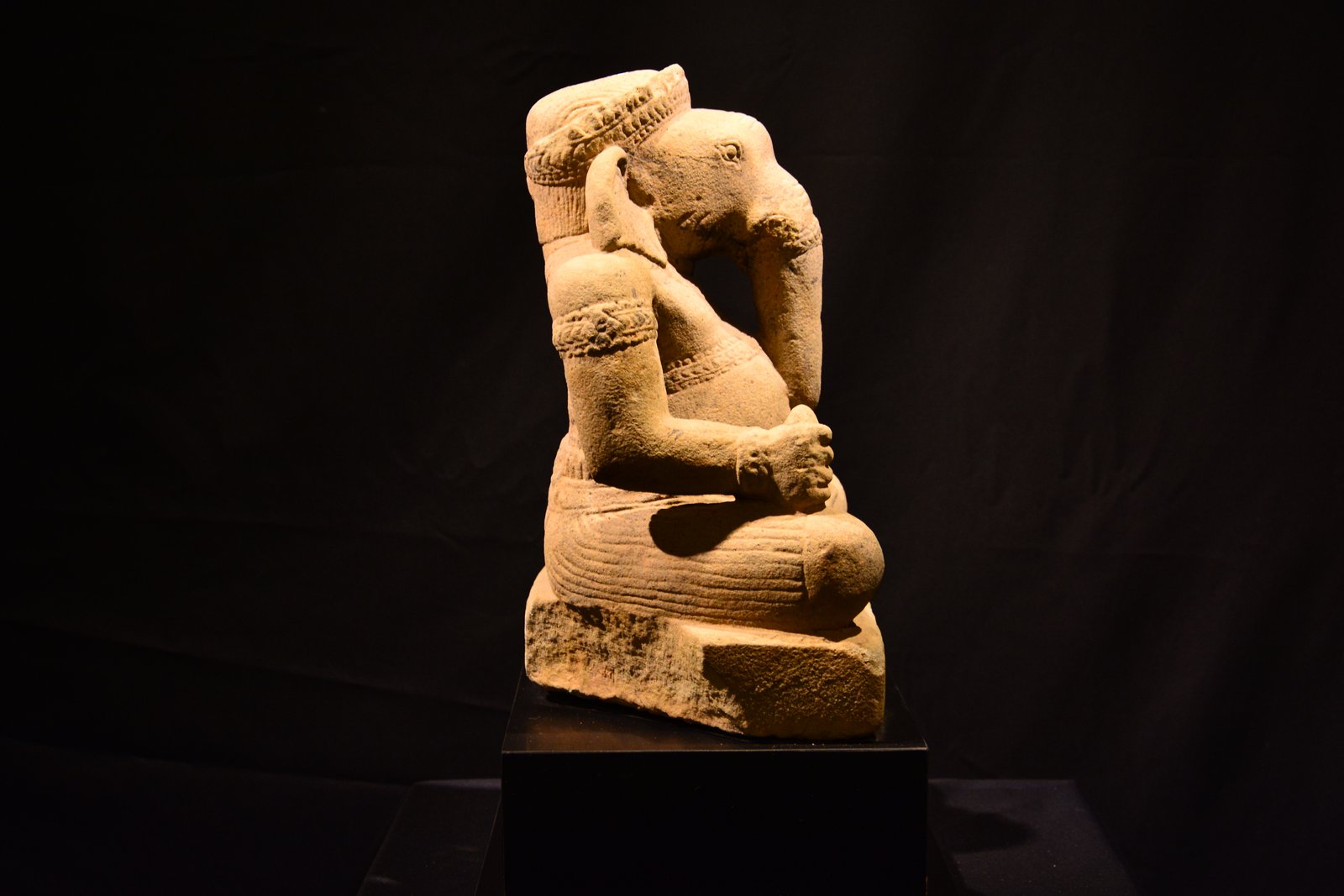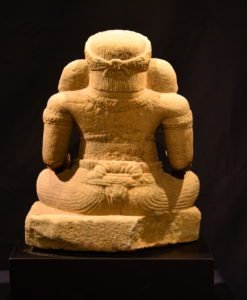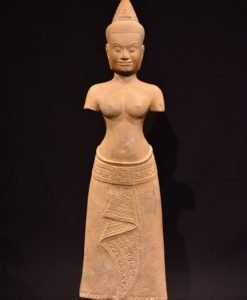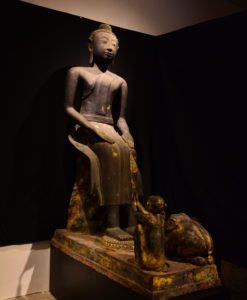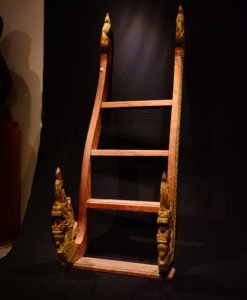Angkor Wat Period Sandstone Ganesha Statue – Khmer Hindu Art, 34 cm
Angkor Wat Period Sandstone Ganesha Statue – A Rare Khmer Interpretation of the Remover of Obstacles
This finely carved 34 cm sandstone statue of Ganesha, the elephant-headed deity of wisdom and beginnings, is a significant artistic and spiritual representation from Cambodia’s Angkor Wat period (c. 1113–1150 CE). Rich in detail and iconography, the sculpture embodies both the refined aesthetics of Khmer craftsmanship and the enduring presence of Hindu deities within the syncretic religious life of the Khmer Empire.
ITEM DESCRIPTION
Iconography & Symbolism
The figure is unmistakably Ganesha—the Remover of Obstacles—portrayed with his iconic elephant head, rounded belly, and multiple symbolic attributes. He is seated in a relaxed cross-legged posture, with one leg gracefully lowered, suggesting a position of calm authority.
The right hand holds what appears to be a broken tusk, a classic symbol in Hindu mythology representing Ganesha’s act of sacrifice and resilience—he famously broke it off to write the Mahabharata. In the left hand, a rounded object rests, likely a sweet (modaka) or a pot, both of which symbolize spiritual abundance and the sweetness of enlightenment.
Khmer Royal Aesthetic
One of the most notable features of this piece is the tiered Khmer-style crown (mukuta), rising symmetrically from Ganesha’s head—an iconographic device reserved for deities of high celestial or royal standing. Such crowns were not merely decorative; they conveyed divinity and power, mirroring the regalia of Angkorian royalty.
His upper arms are adorned with elegant armbands, and a finely rendered belt or sash rests around the waist. The deity’s upper torso is bare, a stylistic decision that highlights both naturalism and sacred idealization, while the lower garment resembles a traditional sampot, its contours gently carved into the light brown sandstone surface.
The overall facial expression is one of peace, the eyes delicately carved to suggest both inner awareness and outer benevolence—a characteristic often seen in Khmer interpretations of sacred figures.
Material and Carving Technique
Crafted from a light-brown, fine-grained sandstone—a material favored throughout the Angkor region for its balance of durability and workability—the statue shows signs of age and earth wear, particularly subtle abrasions likely caused during excavation or storage. These marks, rather than detracting, authenticate the piece and speak to its journey through time.
The original integrated base, carved from the same block of sandstone, remains intact, giving the figure solidity and presence. For ease of display, a custom museum-style plinth is included, enhancing its visual prominence while maintaining structural safety.
Historical and Cultural Context
During the Angkor Wat period, the Khmer Empire was at its zenith, with expansive temple-building campaigns and a deep interweaving of Hindu and Buddhist traditions. While Vishnu was the primary deity of the state religion, Ganesha was venerated widely, often placed at thresholds or entrances as a guardian and bringer of auspicious energy.
Ganesha’s presence in Angkorian art reflects not only the spread of Indian religious ideas but also their local reinterpretation. Khmer Ganeshas are distinguished from their Indian counterparts by distinct stylistic elements: sturdier body proportions, simplified iconographic motifs, and localized dress patterns. This piece adheres to that regional language—rooted in Indian symbolism but undeniably Khmer in execution.
Collector’s Value and Display Potential
For collectors, this statue offers much more than aesthetic charm—it is a tangible connection to one of Southeast Asia’s greatest civilizations. Compact enough for refined interior display yet monumental in cultural presence, it would make an outstanding focal point in a personal collection, spiritual setting, or high-end gallery space.
Its untouched, unrestored condition, combined with the presence of both original and custom display bases, adds to its rarity and desirability. The absence of modern intervention allows the sculpture’s authenticity and soul to speak clearly.
References
-
Jessup, H. I. (2004). Art and Architecture of Cambodia. New York: Weatherhill & The Asia Society.
-
Rooney, D. (2011). Khmer Ceramics & Khmer Sculpture: Treasures of the Khmer Empire. River Books.
-
Bautze-Picron, C. (2003). The Divine Gestures: Iconographic Studies on Hindu and Buddhist Sculptures in Southeast Asia. EFEO.
-
British Museum (2023). Ganesha in Southeast Asia: Iconography and Context. [online] Available at: https://britishmuseum.org
Origin: Cambodia
Period: Angkor Wat
PRODUCT DETAIL
Medium: Sandstone
Dimensions:
Height 34 cm
Length – cm
Wide 27 cm
Condition Report: –
Please keep in touch for Price and more information: Mallika1013@gmail.com






